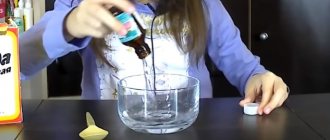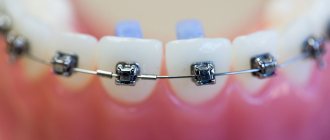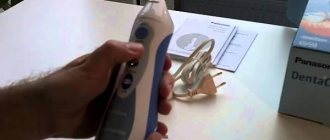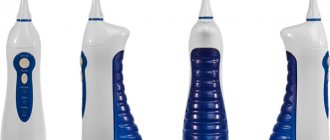Mouthwash: what is it and why is it needed?
Mouthwash is a solution that is part of comprehensive hygiene measures for teeth and gums. Its use enhances the effect of toothpaste and provides better protection against external factors throughout the day. It is found on sale in ready-to-use form, in powder form, which requires subsequent self-dilution, and also in a concentrated state.
Mouthwash is part of comprehensive oral hygiene
Unfortunately, the bristles of a toothbrush cannot always penetrate hard-to-reach places. Interdental spaces, mucosal folds (especially remote ones) and other areas often remain untouched during routine hygienic cleaning. As a result, pathogenic microorganisms accumulate in them, which over time cause inflammatory processes, the appearance of an unpleasant odor, destruction of enamel and other pathologies. The rinsing solution eliminates areas of bacterial accumulation and improves the quality of the hygiene procedure.
Choosing a place for the irrigator in the bathroom
The devices are:
- stationary, with a large liquid reservoir (their operation requires access to an electrical network);
- portable, more compact, equipped with batteries or rechargeable batteries;
- flow-through - they use the pressure of the water supply system and do not require additional power when installed on a tap;
- mechanical - in them the pressure is achieved by manually acting on the piston (nowadays this is rare).
If the device is large, it can be installed on a bedside table or dressing table - the main thing is that the surface is horizontal, flat and stable. There should be a power outlet nearby. The same recommendation applies to installing a base that will charge the elements. A small device can be stored in a cabinet, the main thing is that no liquid gets on it and there is no risk of dropping it.
Who needs an irrigator and who doesn't?
Of course, the presence of such a device would be desirable in absolutely every home, such as, for example, a good electric inhaler. After all, if a person constantly goes to the dentist with problem teeth, the doctor may suspect that they are genetically bad and advise purchasing a device for cleaning the oral cavity, which he uses in his own office.
If purchasing it for a person is one of the mandatory points in treatment, then, most likely, you will also need to buy a special cleansing solution, because ordinary water does not have medicinal properties.
Vital
And yet there is a category of people for whom an irrigator is a real salvation. These people include patients with diabetes. The nature of their illness is such that any wounds, especially those that bleed, heal very poorly and tend to fester.
These also include wounds that form on the oral mucosa due to many reasons, the simplest of which are stomatitis, a burn, or just a minor injury on the edges of freshly baked bread, for example. The irrigator will prevent their occurrence.
People with orthodontic structures in the form of braces, implants (crowns, dentures). In this case, no toothbrush can replace an irrigator - only this device can fully clean a variety of dental structures from microorganisms that settle on them. It is because of them that teeth under crowns and in place of metal braces so often deteriorate.
Those with braces are strongly advised to use an irrigator.
There are even irrigators specially designed for orthodontic structures. An irrigator is necessary for those who suffer from bad breath. This smell usually comes from food debris that is difficult to remove with a brush from hard-to-reach places. Also, people with so-called crowded teeth cannot do without it - a feature of the structure of the jaw or bite in which the teeth are tightly pressed to each other, which complicates their cleaning.
Can not use
In exceptional cases, it is not advisable to use an irrigator to clean the oral cavity, as this may aggravate the situation. These include:
- recent surgery, after which sutures or wounds have not yet healed;
- undergoing professional dental treatment;
- increased bleeding of gums after a person uses an irrigator for some time;
- when chronic dental diseases worsen, for example, gingivitis or stomatitis;
- inability to use the device, for example, by small children who may simply swallow liquid from the nozzle.
Even after reading all of the above, you may wonder why you need an irrigator and whether this device is such a necessary thing in everyday life. Of course not. But if you want to shine with a natural smile for a long time, it’s time to think about purchasing it.
Can I give a waterpik to a child?
Irrigator for children
Yes, children can also use an irrigator. But this needs to be done when there is a parent nearby and with minimal pressure. It is also important that the child has his own brush head, just like a toothbrush.
Before using an oral irrigator, watch our video with your child. This way, the baby will not be afraid of the device and will understand its benefits and operation together with you.
Rules and methods for using concentrates in irrigators
In most cases, a specialized liquid for an irrigator is universal; it can be used both in the device and independently, as a rinse aid. Despite this, there are simple rules that should be followed when handling concentrates:
- First of all, before using the balm, you need to read the instructions, learn about side effects, contraindications and methods of use. Most solutions need to be diluted with water in a ratio of 1:10, but there are also those that are diluted 1:5. This rule is important to follow, otherwise you can harm your health
After the solution is prepared, it should be poured into a special reservoir of the device. As noted above, most balms can be used daily, after meals as a rinse; just pour it into the cap, filling it one-third full, add water up to the mark, and rinse your mouth with it for about 2 minutes. It is important to take precautions, no matter how harmless the solution may seem at first glance, it should not be swallowed. It is important to monitor children who, due to their age, cannot assess the consequences of improper use of concentrates.
How to properly use an irrigator to clean your teeth and mouth
As a rule, a set contains several attachments (if the device is used in turn, each user should have an individual one - it is convenient to purchase a set marked in different colors, or mark it yourself with permanent markers). They are designed for various purposes:
- daily care procedures;
- removal of plaque and hard deposits;
- cleaning periodontal pockets (periodontal);
- tongue cleaning.
There may be many variations, but these are basic and sufficient for complete regular care.
There are also rules for operating the device. To achieve maximum therapeutic effect it is necessary:
- use it only after standard brushing at least once a day before bed;
- if you have braces, plates or other structures for correcting the dentition, wash them every time after eating;
- massage the gums only in a gentle manner so as not to damage the delicate skin;
- do not use floss (thread) before the hardware procedure - it can injure soft tissues, and a stream of water will only aggravate the situation;
- keep your tongue up so that the filler cannot enter your respiratory tract.
What kind of liquid can be poured into the irrigator?
ordinary water and special liquids are used as filler for the device .
The latter not only mechanically remove plaque from the enamel, but also have a different therapeutic effect depending on the properties of the liquid.
About water for the device
Water is poured distilled, filtered (a simple “jug” filter with a new cartridge is enough), or at least boiled , and then settled. The temperature should be about +40 °C , comfortable for the oral cavity.
This is interesting: Personal hygiene for teenagers
Important! If you use raw tap water or water with too low a temperature, this will affect the health of your teeth and the condition of the appliance .
Store-bought teeth cleaning products
If an additional goal is disease prevention and dental treatment , it is recommended to purchase professional liquids for irrigators at the pharmacy.
They can be either universal or come complete with a device from the company. Special solutions always contain various microelements, vitamins and plant extracts .
Based on their action, the following types of liquids are distinguished:
- To strengthen enamel with fluoride and calcium.
- From unpleasant odor in the mouth with natural flavors.
- From bleeding gums . This symptom usually occurs in people with tartar or periodontitis.
- For sensitive teeth. The components of such solutions are hypoallergenic .
Liquids can have a wide range of applications. They have an antiseptic effect , increase local immunity in the oral cavity and prevent the formation of tartar.
Such store-bought solutions are used as preventive measures. They often contain chlorhexidine .
There are also dental solutions that are used only by professionals, i.e. doctors, in clinics. They are intended for treatment in the postoperative period and are used together with other physiotherapeutic procedures prescribed by the doctor.
Such liquids contain various antiseptic components, for example, miramistin, and biologically active substances . Such solutions are always concentrated. For therapeutic irrigation, they are diluted with saline solution. In each case, the dentist prescribes a specific drug taking into account the patient’s clinical picture.
Liquid for irrigator
Refilling the irrigator with a special liquid.
Recently, among oral care products, irrigators are gaining more and more popularity. Their principle of operation is based on the supply of a jet of special liquid under pressure, which cleanses the oral cavity and all its components from bacteria, plaque and dental deposits.
The functional purposes of liquids for irrigators include:
- Preventing the development of bleeding gums, gingivitis, periodontal disease.
- Strengthening gums.
- Strengthening the effect of using the device itself.
- Enrichment of the oral mucosa with minerals.
- Eliminating bad breath.
The use of liquids in an irrigator provides more thorough sanitation of the oral cavity. This occurs as a result of the penetration of the solution into hard-to-reach places between the teeth and into the periodontal tissues themselves.
Advice! Experts recommend using special solutions for irrigators. As a rule, their composition is enriched with useful substances, which ensures their wide spectrum of action.
Liquid release forms. Concentrates and balms
They are different and differ in concentration :
- Rinses and balms . This is a ready-made product, which is immediately poured in its pure form into the container of the irrigator. The amount of solution to be poured will depend on the volume of the device and the amount of liquid that a person needs for one use. The bottle volume is usually 200 ml . Examples: Professor Persin, Waterdent, Donfeel.
- Concentrates. They are already pre-diluted with boiled or filtered water in certain proportions specified in the instructions for the product. Usually it's 1:10 . Examples: Irix, Albadent, Asepta.
After each procedure, the irrigator container is cleared of any remaining liquid and rinsed well with clean water.
Important! Liquid for irrigators should not foam, as foam interferes with pressure.
This will help avoid unpleasant odors and extend the life of the device.
How to clean the waterpik after use
Regardless of the frequency of use of the irrigator, it requires maintenance after each procedure. First of all, the remaining liquid is poured out of the tank to avoid the appearance and proliferation of harmful microorganisms. At the end of each use, the device is turned off, the nozzle is removed, and the remaining water or solution is removed from the container.
After this, the device must be rinsed and dried thoroughly. After use, the nozzle is washed with liquid soap, rinsed with running water and wiped dry with a clean napkin. Disinfection and cleaning of the device should not be carried out with boiling water, since its impact can damage and deform the housing.
If there is any remaining liquid, it is removed by putting the nozzle on and pointing it into the sink. The device turns on and operates for 2-3 seconds, during which all the water from the tubes comes out. The irrigator, washed and wiped dry, is left in the air until the next use.
Even the cleanest water contains impurities that gradually settle, clogging parts and mechanisms. If this happens, you need to use special means and treat the inside of the device. It is also recommended to replace nozzles in a timely manner at intervals of 3 to 6 months. Avoid dropping the device and periodically check all electrical connections.
Types of rinsing solutions
Let's look at the classification of the funds presented today.
Type
There are preventive (hygienic) and therapeutic.
Preventive ones freshen breath, eliminate food debris, prevent the occurrence of dental problems and relieve inflammatory symptoms, strengthen gums and enamel, protect them from bacterial attack, but they are not able to cope with existing serious dental diseases.
Important! Under the guise of “preventive”, today you can find products that only perform the function of freshening breath. That's all. They differ little from each other in composition, and bad breath is often simply masked rather than eliminated the cause of its occurrence. They are of poor quality, contain toxic ethanol, can stain enamel, harm gums, and do not protect the oral cavity from bacteria at all. To avoid disappointment, be sure to consult with your dentist before making a choice.
Therapeutic drugs help in the fight against serious pathologies, but they should be used only as prescribed by the attending physician and at a strictly prescribed time (in courses). Remember that uncontrolled use without assessing and taking into account the real situation in the oral cavity is not a joke.
There are many types of rinses
By purpose
All available types from the great variety of rinses can be divided into 6 types, each of which must be selected in accordance with the problems that you have.
Protection against caries
Products from this series reduce the volume of plaque and thereby protect against caries, reduce the level of acidity in the mouth and strengthen the enamel. They contain calcium, potassium, fluorine ions, amino fluoride or sodium fluoride, plant components, xylitol. Among them are: Elmex “Protection against caries”, PresiDENT Classic Plus, Donfeel and 4-action Mouthwash from Biorepair, Listerine EXPERT “Protection against caries”.
Eliminating bleeding
Irrigating fluids used to irrigate the oral cavity may have an anti-inflammatory effect. As a rule, such balms are recommended for use in cases of gum disease, as well as damage to the oral mucosa.
The solutions contain extracts of medicinal plants: sage, oak bark, chamomile, calendula or St. John's wort, which not only eliminate bleeding gums, but also have an antiseptic and deodorizing effect. Triclosan or chlorhexidine are added to special medicinal elixirs - substances that have a powerful antibacterial effect.
Gum protection
They relieve inflammation and saturate the gum tissue with nutrients, allowing the first manifestations of gingivitis to stop. Among the active compounds they contain chlorhexidine, methyl salicylate, triclosan, benzydamine.
This group includes: Parodontax Extra, PresiDENT “Profi”, CURASEPT ADS with chlorhexidine and hyaluronic acid1, Paroguard from Miradent, Twin Lotus, Splat “Active”. You can use Listerine EXPERT “Gum Protection”, because, as the manufacturer assures, it reduces the inflammatory process by 94%2 and reduces plaque formation by 70%.
The photo shows rinses to protect gums
On a note! Products containing triclosan and chlorheskidine should not be used for more than three weeks in a row, because They, along with a positive effect, can disrupt the composition of the microflora of the oral cavity, cause dry mucous membranes, make the enamel dark and even contribute to the appearance of bad breath.
Enamel whitening
Helps dissolve plaque and reduce the number of bacteria in the oral cavity. Contains active oxygen and hydroxyapatite. For example, GLOBAL WHITE and Blanx White Shock, INNOVA, Listerine EXPERT “Expert Whitening”.
However, you should not expect that they will whiten your teeth by more than 0.5-1 tone; for more dramatic changes, contact a professional dentist.
Daily care and prevention
Permanent comprehensive protection of teeth and gums. Such products can be used every day on an ongoing basis. For example, the “Forest Balm” series, Colgate Plax “Refreshing Mint” (“Colgate”), Listerine “Strong Teeth, Healthy Gums”, “Green Tea”, “Fresh Mint” or TOTAL CARE, SPLAT “Healing Herbs”.
This is interesting: Miramistin - instructions for use in dentistry
To protect sensitive enamel
This classification or type of rinse aid usually includes fluoride and potassium, aluminum. The components reduce irritation from external factors and restore the surface of the teeth. An example would be: Elmex Sensitive+, Lacalut Sensitive, ROCS “Active Calcium”, Colgate Plax “Freshness of Tea”.
Action
Choose your irrigator fluid based on your doctor's recommendations.
Irrigator fluids have the following effects:
- Disinfectant. These liquids contain antiseptic components that effectively destroy bacteria in the oral cavity and prevent their proliferation.
- Therapeutic. These are special liquids containing calcium or fluoride that promote remineralization of dental bone tissue. The presence of medicinal herbal extracts in the compositions provides a wound-healing effect, relieves inflammatory processes and pain syndrome in periodontal diseases.
- Deodorizing. Such solutions contain mint or menthol components, which provide fresh breath for a long period of time.
- Preventive. The use of special liquids intended for daily use prevents the development of various dental pathologies. At the same time, the bone tissue of the teeth and gums is enriched with useful substances and minerals. Also, such solutions are able to stimulate blood microcirculation in periodontal tissues, which leads to strengthening of teeth and gums.
Reference! In many ways, the effectiveness of using an irrigator depends on the correct choice of liquid. Its choice should be made exclusively by a specialist, taking into account the clinical picture in the oral cavity and the pharmacological action of the drug.
Basic rules for choosing a liquid
When choosing a solution for an irrigator, you should consider its purpose and composition. Depending on the active components, the solutions used during irrigation are intended for:
It is also worth considering the type of liquid. It is strictly forbidden to use professional compositions at home. People prone to allergies are recommended to give preference to hypoallergenic balms. When preventing dental pathologies, as well as for children, special gentle formulations should be used, preferably without alcohol.
If there is a problem with the constant occurrence of inflammation of the mucous membranes of the oral cavity, preference should be given to liquids that have an anti-periodontal effect. They contain compositions of various bioantioxidants and anti-caries additives.
A preliminary consultation with a dentist will help you make the right choice. Using unsuitable solutions can lead to side effects such as thinning or darkening of tooth enamel.
Top 9 best oral solutions
| Name | Description and benefits | Price |
| Waterdent _ | Concentrated phytocomplex containing fluoride, which is additionally used for rinsing the mouth. Effectively cleans interdental spaces, periodontal pockets, braces, implants and other types of dentures. Contains bischofite, chlorhexidine and xylitol. | From 365 rubles |
| Donfeel (Donfil) | It has two types: a solution for daily use and for the prevention of dental pathologies. Depending on the purpose of the liquid, it contains various natural components based on extracts of medicinal herbs: lemon balm, mint, chamomile, calendula and echinacea. The absence of alcohol-containing components allows this liquid to be used by children. | From 230 rubles. |
| TerraSol (Terrasol) | Available in the form of a concentrate. Characterized by a powerful antimicrobial effect. The color of the liquid is deep blue, which limits its use to people prone to allergic reactions. | From 380 rubles. |
| Peridex (Peridex) | Refers to professional products. Contains 0.2% chlorhexidine. The main pharmacological action is the removal of bacteria in the oral cavity. This allows the drug to be widely used for therapeutic purposes and especially after surgical interventions. | From 120 rubles. |
| PerioGard (Periogard) | An effective liquid that has an antiseptic effect. It does not contain alcohol and contains chlorhexidine digluconate at a concentration of 0.2%. Clinical indicators: reduces the formation of dental plaque, prevents the development of gingivitis, inhibits the growth of bacteria, relieves periodontal inflammation. Designed for daily use. | From 285 rubles. |
| Asepta | Concentrate for a broad-spectrum irrigator. The active ingredients ensure the removal of bacterial plaque, prevent the deposition of tartar, eliminate inflammatory processes in the periodontium and its bleeding. An ideal product for the care of dental structures of any type. | From 415 rubles. |
| Albadent | A universal concentrate, which can be used daily as a hygiene product, or as a preventative drug, as well as in the treatment of periodontal disease and gum inflammation. The active components of the product help reduce the sensitivity of tooth enamel, effectively strengthen it and eliminate plaque of any density. | From 245 rubles. |
| Irix | Contains disinfectants. Helps reduce gum bleeding and prevents the development of carious lesions. The presence of menthol in the composition provides refreshment of the oral cavity for a long period of time. One of the main advantages is the absence of foam when using the product. | From 480 rubles. |
| Professor Persin | Fluoride-free liquid based on medicinal herbs. Intended for daily use for the prevention of various dental pathologies, especially gingivitis and caries. When foci of inflammation develop, it effectively stops them and stimulates tissue regeneration. | From 460 rubles. |
The best anti-caries mouth rinses
President Classic Plus
The rinse contains sodium fluoride (250 ppm), xylitol and plant components (extracts of lemon balm, sage and chamomile). Protects tooth enamel from damage by caries and has a pronounced refreshing effect. It does not contain antiseptics or alcohol, so it is approved for use in children over 6 years of age and people whose profession involves driving vehicles.
Main advantages:
- pleasant aroma,
- soft taste,
- long lasting breath freshening.
Contraindications for use of the device
In addition to the enormous benefits, the presented device has contraindications:
- postoperative period of dental surgery;
- stage of exacerbation of gum disease;
- recovery period after installation of braces or implants;
- diseases of the cardiovascular system, which lead to bleeding gums due to damage to blood vessels;
- period of course treatment of dental diseases.
Cleaning the bracket system
It is not recommended to use the irrigator for children under 6 years of age, as well as for those people who have previously experienced prolonged bleeding of the gums.
The best rinses for complex therapy of periodontal diseases
Lacalut active
Lacalut active mouth rinse is produced in Germany. It contains sodium fluoride (225 ppm), 0.25% chlorhexidine digluconate, aluminum lactate and does not include ethyl alcohol. An antiseptic (chlorhexidine) fights the development of the infectious process, aluminum lactate has an astringent effect, which eliminates bleeding gums, and sodium fluoride protects teeth from caries. Lakalut asset cannot be used for more than 21 days. Main advantages:
- effective,
- has a good smell and taste.
Minuses:
- To achieve the expected result, you need to take several courses.
Asepta
A Russian rinse that contains two antiseptics (chlorhexidine bigluconate - 0.05%, benzydamine - 0.15%), xylitol. It has a pronounced antibacterial effect and a slight analgesic effect. The drug can be used in the treatment of ulcerative-necrotic and hypertrophic forms of gingivitis (inflammation of the gums). The maximum permissible period of use is 14 days. With prolonged use, it can cause the development of dysbiosis of the oral cavity. Main advantages:
- mint, not very pronounced taste,
- does not contain artificial colors or alcohol,
- pronounced positive effect.
Minuses:
- quickly consumed.
Stationary irrigators
Such models are usually purchased for family use. They are placed in the bathroom and fixed with special fasteners. Home irrigators include more useful modes of use than portable ones, and a greater variety of replaceable attachments. All this allows for effective preventive and therapeutic procedures. So that each family member can use the device, individual attachments are selected and purchased.
Stationary models usually have:
- 4-10 water supply speeds;
- tank volume 0.5-1 liter;
- water pressure 200-800 kPa.
The best plant-based mouth rinses
Forest balm
Mouthwash from the Forest Balm brand is intended for comprehensive maintenance of the oral cavity in a healthy condition. It will not solve serious problems, it is intended mainly for prevention. The product protects against caries and strengthens enamel due to a mineral complex with fluoride. The Russian concern Kalina produces Forest Balsam rinse in 13 versions, not all of them have a purely herbal composition. Some may contain fragrance, an organic solvent, or the antiseptic triclosan. When purchasing, you should pay attention to the components included in the product. Main advantages:
- pronounced effect,
- pleasant taste,
- affordable price.
Minuses:
- the composition is not 100% natural.
MEXIDOL dent Professional
Rinse aid made in Russia. The composition includes: anti-inflammatory component methylhydroxyperidine succinate (or Mexidol), licorice root extract, amino acid complex. Suitable for periodic use, prescribed to prevent the development of inflammatory processes for people prone to developing stomatitis and those who wear removable dentures. Main advantages:
- moisturizes the mucous membrane,
- heals wounds with stomatitis well.
Minuses:
- Recommended only for certain diseases.
How to care for your irrigator so it lasts longer
The device must be cleaned in a timely manner to avoid the formation of plaque on its internal walls. For this:
- disconnect the container, turn it over and rinse it under a powerful stream;
- wipe the inner surface and body with a soft cloth or sponge;
- to clean the structure, it is advisable to use specially designed cleaning products that remove dirt and prevent the appearance of scale;
- Always clean the device immediately after using medicinal balms and herbal infusions;
- All parts should be completely dry before final assembly.
Do not use abrasive and aggressive agents, as well as hard water, as this will damage the parts. Store the device in a dry place to prevent mold growth. Some models come with special sterilizers for processing nozzles - do not neglect them.
The best mouth rinses for hyperesthesia (increased sensitivity) of teeth
Lacalut sensitive
The German LACALUT sensitive mouth rinse is a prime example of excellent quality at a reasonable price. Reduces the sensitivity of enamel to hot and cold, sweet and sour. Protects sensitive teeth from caries, strengthens gums. In addition to amino fluoride, the drug contains aluminum lactate with a pronounced astringent effect and an antiseptic, which requires use for no more than 21 days. Main advantages:
- Reduces tooth sensitivity well
- refreshes the oral cavity,
- helps cope with bleeding gums.
Minuses:
- The bottle lasts for a short time.
Since many rinses contain antiseptics or alcohol, it is not recommended to choose them yourself. In order for the effect of the rinse to be maximum, you need to contact a dentist to determine the problems of the oral cavity and carry out complete sanitation (treatment of all dental diseases) and professional hygiene.
Contraindications to using an irrigator
If you have systemic or severe diseases, you should discuss with your dentist how many times you can use the irrigator. Be careful:
- with bleeding gums;
- increased sensitivity to mechanical irritants;
- in the presence of cracks, thinning of the enamel;
- infectious diseases of the oral cavity;
- inflammation, damage to the gums and mucous membranes of the oral cavity;
- enamel hypersensitivity.
Whether it is possible to use an irrigator for periodontal disease, the doctor determines only after an examination. In case of significant damage or infection, the use of the device is not recommended. Periodontal disease and caries always require professional help - home methods of self-medication cannot stop the pathological process.
The best rinses with teeth whitening effect
Whitening rinses prevent the appearance of enamel stains, plaque and tartar, and also help to gently brighten the surface. However, you shouldn’t expect the effect of professional whitening and a difference of 3-4 tones from them, of course.
Colgate Optic White – popular whitening rinse
Colgate Optic White removes plaque and stains on enamel, thereby restoring the natural whiteness of teeth. The effect is visible within a week after daily rinsing. The mint in the composition not only gives a pleasant taste to the product, but also destroys bacteria, freshening your breath. The feeling of cleanliness remains until the next meal.
The rinse aid is sold in white plastic bottles of 250 or 500 ml. The cap serves as a convenient dispenser. A volume of 500 ml when used twice a day is enough for about a month.
Pros:
- removes plaque and stains on teeth;
- eliminates unpleasant odor;
- does not sting when rinsing;
- low consumption;
- sold in most stores.
Minuses:
- short-lived whitening results;
- not recommended for sensitive teeth.
Colgate Optic White mouthwash is most effective when used with a toothpaste and brush from the same series.
Splat Active White – effective whitening rinse
Splat Active White is recommended for regular use after meals to maintain oral hygiene. It actively fights plaque and stains from dark drinks, and also freshens breath. The proprietary patented Luctatol system prevents the appearance of caries, blocking plaque deposition by 96%. However, the list of active ingredients here is quite extensive.
This is interesting: Choosing toothpaste for braces: recommendations from dentists
Tetrasodium glutamate diacetate and the plant enzyme papain ensure the removal of pigmented plaque. Lactic enzymes and zinc ions create an antibacterial barrier, block the development of pathogenic flora and fight unpleasant odors. Licorice extract helps prevent caries. Biosol and thyme essential oil provide anti-inflammatory and antiseptic effects to prevent bleeding gums.
Pros:
- affordable price (about 150 rubles for 275 ml);
- pleasant taste;
- noticeable whitening effect;
- suitable for irrigators;
- prevention of bleeding gums.
Minuses:
- you need to keep it in your mouth for a whole minute;
- may cause allergies.
The rinse is recommended for use with Splat Professional “Whitening Plus” paste for maximum brightening results. The product is compatible with irrigators and is suitable for people with braces and other orthodontic structures.
What is the irrigator created for?
Modern dentistry is aimed not only at high-quality dental treatment, but primarily at disease prevention. For this purpose, a hygiene device was developed, namely, removing food debris, washing away bacteria, cleaning hard-to-reach places, neutralizing an acidic environment, and preventing tartar. It's called an irrigator. The device looks like a reservoir into which a special liquid is poured, and then the oral cavity is irrigated under pressure with a thin stream from the nozzle.
Advantages of using an irrigator:
- available for purchase: can be found at an electronics store at a reasonable price;
- easy to operate;
- easy to clean;
- instead of special solutions, you can pour ordinary water into the tank;
- promotes effective cleansing of hard-to-reach places;
- Cleaning time is fast;
- does not cause pain or discomfort;
- helps wash away pieces of food, improve gum health, improve blood circulation;
- has no harmful effects;
- no side effects;
- recommended when wearing braces or dentures;
- the effect is higher than when using dental floss;
- improves oral health in two weeks.
Best lists
Let's determine the most effective mouth rinses by category:
- budget;
- anti-caries;
- for children.
Budget
Fluorodent is the most budget-friendly mouthwash option on our market. Its price ranges from 40 to 110 rubles. But still, this product has an antibacterial effect, strengthens enamel, whitens, and freshens breath. The structure of the rinse is based on a mixture of essential oils: lemon, mint, anise, clary sage.
mouth rinse Fluorodent.
Anticarious
Elmex “Protection against caries” copes well with its main task, but also has an antibacterial effect and strengthens the enamel. The cost of the product is generally 600 rubles.
Elmex mouth rinse Protection against caries.
For children
Drakosha is an excellent representative of a baby mouthwash. You can purchase it for up to 100 rubles. It is absolutely safe for your children, but it is better to make sure that the child does not swallow this liquid.
Drakosha mouth rinse.
What to do if you run out of liquid?
You can prepare the liquid for the irrigator yourself. For example, at home you can use the following recipes:
- Baking soda solution: 2 dessert spoons per 300 ml of water. The solution has a strong antimicrobial effect and provides complete care for enamel and gums.
- Table salt solution: a teaspoon per 200-250 ml of boiled water. Effectively destroys pathogenic bacteria, but is not suitable for frequent use: it weakens tooth enamel.
- Hydrogen peroxide solution: 3 full caps of 3% composition are dissolved in a glass of water. This is an excellent antiseptic for caries prevention.
You can also make a solution from decoctions of medicinal herbs and plants: fireweed, sea buckthorn, chamomile, etc.
In any case, the liquid prepared by yourself must be of a uniform consistency and not contain undissolved particles that could damage the device. Therefore, it is better to purchase liquids for irrigators in ready-made form.
Which liquid to choose directly depends on the dental problem that needs to be solved. There are no universal drugs that can get rid of all diseases. We recommend not to self-medicate, but to consult a dentist. The doctor will identify the problem and select the best liquid for the irrigator that can solve the problem without risk to health.
Recipes for making your own liquids for irrigators
Many experts recommend using homemade solutions from gentle ingredients that are easy to make with your own hands:
- Soda solution. 10 g of baking soda should be thoroughly dissolved in 0.3 liters of warm boiled water.
- Salt liquid. Mix 300 ml of warm purified water with 5 g of unflavored sea salt. Stir until it is completely dissolved.
- Hydrogen peroxide based solution. Mix 250 ml of water at room temperature with 10 ml of the main raw material.
Important! Despite the ease of preparation of these solutions, their use and duration of use should be agreed with a doctor. Incorrect concentration and prolonged use can lead to dehydration of teeth, increased sensitivity, as well as destruction of connective tissue and loss of dental strength.
Types of irrigators
Irrigators can be stationary, portable, or from a water tap. Each of these types has its own advantages and disadvantages.
Stationary.
The whole family can use these irrigators. Many models include not only different types of attachments according to function, but also several basic attachments of different colors for individual use by family members. Has a large water tank. It operates from a 220 volt electrical network, for which you need to have a nearby outlet. The best option for regular use at home.
Poles:
- no need to spend money on batteries;
- a large water tank allows for long and thorough cleaning;
- removable attachments included in the kit allow you to brush the teeth of all family members;
- durable and long lasting.
Minuses:
- inconvenient to take on the road;
- It is impossible to use a “savage” in a tent.
Portable.
Such irrigators are strictly individual, as they do not have additional main attachments. Attachments for special functions are also not always included. The power source is a battery or batteries. They have a small water tank (no more than 150 ml). Used in road and camping conditions.
Pros:
- lightness and space saving in luggage;
- can be used in the absence of electricity.
Minuses:
- electricity is still needed to recharge the battery;
- financial disadvantage when changing batteries frequently;
- with constant use they break more often than stationary irrigators;
- with a small container for water, it is sometimes not enough to carry out a thorough procedure;
- when turning the handle, a stream of water is not supplied to the nozzle, which limits the virtuosity of using the irrigator;
- This irrigator can only be used by 1 person;
- Not all accessories with special capabilities are included.
From a water tap.
This type of irrigator operates directly from a water tap by connecting it to a handle using a special hose. Models come in both individual and family sizes. This type of irrigator is not recommended by all experts due to significant disadvantages.
Pros:
- no electricity or batteries needed;
- compact and lightweight;
- unlimited amount of water when used.
Minuses:
- the quality of tap water may not meet sanitary requirements;
- With such a device it is very difficult to regulate the pressure of the water stream, because the pressure in the water tap is constantly changing;
- When using such an irrigator, it is possible to use only tap water, but sometimes it is necessary to use medicinal compounds.
Using the irrigator correctly - step-by-step instructions
- Fill the reservoir with water or a special liquid at a comfortable temperature.
- Select the desired nozzle and install it on the handle of the device.
- Adjust the jet pressure.
- Place the nozzle in your mouth and press it lightly with your lips, then turn on the device.
- Lean over the sink and open your mouth slightly to allow the water to flow into the sink after cleaning.
- Direct the jet towards the teeth at a 90 degree angle. Dentists recommend this cleaning scheme: divide the entire jaw into four parts and treat them one by one. For example, first the upper left part is processed, then the upper right, then you can move on to the lower jaw using the same principle.
- When moving from one tooth to another, you need to stop at the interdental spaces, because Small pieces of food often remain between them and bacterial plaque accumulates.
- After treating the entire oral cavity, remove the nozzle and install it on a special mount.
- Drain the water tank.
Remember! When cleaning your gums, you need to hold the nozzle so that the stream is directed from top to bottom. This precaution will prevent the gum tissue from moving away from the tooth.
Tips for making your mouthwash as effective as possible
To achieve a pronounced effect from using a rinse solution, you will need to follow some recommendations:
- The optimal moment for rinsing is considered to be the time after brushing the teeth, when their surface is most “open” for the absorption of active substances,
- You should not put more than 20 ml of product into your mouth, and do not take the rinse aid several times. This will not affect the final result, but more solution will be needed. In addition, the likelihood of components entering the gastrointestinal tract increases, which can lead to stomach and intestinal upset,
- There is no need to dilute the ready-to-use solution with water,
- Some solutions require a longer rinse. This mainly applies to liquids intended for the treatment of dental problems, for example, those containing fluoride and sodium compounds,
- The rinse is not intended for oral use; if you accidentally swallow a small amount, of course, nothing will happen. But we strongly recommend drinking a fairly large amount of plain water, thus flushing your stomach,
- You should not use formulations with alcohol for longer than two weeks in a row - this can cause dehydration of the mucous membrane.
And remember that the mouthwash is by no means a complete replacement for other oral care products: brushes, pastes, irrigators. All of them must be used comprehensively.
Sources:
- https://anZub.ru/esteticheskaya-stomatologiya/opolaskivateli-dlya-rta/
- https://vibiraite.ru/zidkost-dla-irrigatora.html
- https://stomatr.ru/o-zubah/uhod-za-polostyu/rastvor-dlya-irrigatora-polosti-rta-svoimi-rukami.html
- https://stomatologliliya.ru/sredstva/zhidkost-dlya-irrigatora-kak-vybrat-rastvor-ili-prigotovit-ego-svoimi-rukami
- https://teeth-health.ru/rastvor-dlya-irrigatora-polosti-rta-svoimi-rukami/4177.html
- https://denta-log.ru/rastvor-dlya-irrigatora-polosti-rta-svoimi-rukami.html
- https://www.expertcen.ru/article/ratings/luchshie-opolaskivateli-dly-polosti-rta.html
- https://vyboroved.ru/reyting/luchshie-opolaskivateli-dlya-rta
- https://oxko.ru/luchshie-opolaskivateli-dlya-polosti-rta/
- https://waterpikrussia.ru/article/kakaya-zhidkost-dlya-irrigatora-luchshe
- https://dentoland.com/gigiena/chistka/zhidkost-dlya-irrigatora.html
- https://PlastikaPlus.ru/uhod-za-zubami/kak-pravilno-polzovatsya-irrigatorom.html
Will an irrigator replace a toothbrush?
The formation of dental plaque leads not only to caries, but also to more serious periodontal diseases. The gums become more sensitive and begin to bleed, which indicates the onset of inflammatory processes. With further progression of the disease, tissue near the roots begins to deteriorate. Teeth become loose and may begin to fall out.
To avoid this condition, timely prevention is necessary, which involves, first of all, high-quality oral hygiene. All actions, first of all, should be aimed at removing plaque and tartar not only from the teeth themselves, but also from under the gums.
What is better, a waterpik or an electric toothbrush - Can a waterpik replace a toothbrush?
Only a dentist can completely eliminate plaque and other deposits using special means. Therefore, after brushing your teeth in the clinic, you should maintain your hygiene level at home. For this purpose, use a toothbrush at least twice a day. Additional cleaning of the spaces between the teeth is done with a special floss or irrigator.
This device creates a jet of liquid under pressure. Directed to the right places, it removes all unnecessary from hard-to-reach places. At the same time, the gums are subjected to therapeutic massage. The procedure is performed after brushing your teeth with a brush, which first softens all deposits and affects the gums. Further use of the irrigator only consolidates the positive effect.











